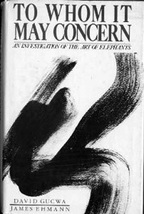14.
Book On Elephant Art
To Whom It May Concern: An Investigation of the Art of Elephants
By David Gucwa, James Ehmann (Co-Authors)

In 1982 James Ehmann (a journalist) and David Gucwa (a zoo keeper) showed to Jerome Witkin (a professor of art at Syracuse University and an authority on abstract expressionism) a set of drawings done by an elephant. They did not reveal to Prof. Witkin the identity of the artist and asked him to evaluate the pictures. The professor said "These drawings are very lyrical, very, very beautiful. They are so positive and affirmative and tense, the energy is so compact and controlled, it's just incredible... I can't get most of my students to fill a page like this." After learning the identity of the artist Witkin said: "Our egos as human beings have prevented us for too long for watching for the possibility of artistic expression in other beings."
In 1984 they sent elephant drawings to the famous abstract artist Willem de Kooning. They did not intend to trick him and included with the paintings a letter explaining their origin. They received the following reply from his wife Elaine de Kooning:
“When Mr. de Kooning and I received your package, before we read your letter, we looked at the drawings and were very impressed by them. We felt they had a kind of flair and decisiveness and originality. Needless to say we were dumbfounded when we read that they were made by an elephant.”
Mr. de Kooning said "That's a damned talented elephant."
Meanwhile, every zoo keeper had noticed that every elephant from time to time picks up a stick or stone and draws something on the floor.
Prior to this book by David Gucwa and James Ehmann, no one had brought to the public's attention that elephants like to draw, and will, without training or reward, doodle spontaneously on the ground with a pebble or stick. In the case of Siri, a 13-year old Asian elephant, her efforts were noted by David Gucwa, her caretaker, who provided drawing materials and collected the results of her endeavors. Her drawings (50 of them are reproduced in the book) have been admired by artists and their significance discussed by evolutionists and cognitive researchers, some of whom affirm artistic intent of the drawings.
A variety of opinions about the drawings from artists, elephant handlers, developmental psychologists, and others are presented. The basic thesis is that the drawings represent real art that changed and improved over time, and that elephant intellect must therefore be accorded greater respect.
This book is startling. The descriptions of human elephant interaction lead us to a deep and profound understanding of these majestic creatures. The art work shows both a stunning sense of design and a certain grasp of artistic metaphor. Critiques by artist etc. further validate this view. The culmination is a reevaluation not only of art but of personhood in general.
In 1984 they sent elephant drawings to the famous abstract artist Willem de Kooning. They did not intend to trick him and included with the paintings a letter explaining their origin. They received the following reply from his wife Elaine de Kooning:
“When Mr. de Kooning and I received your package, before we read your letter, we looked at the drawings and were very impressed by them. We felt they had a kind of flair and decisiveness and originality. Needless to say we were dumbfounded when we read that they were made by an elephant.”
Mr. de Kooning said "That's a damned talented elephant."
Meanwhile, every zoo keeper had noticed that every elephant from time to time picks up a stick or stone and draws something on the floor.
Prior to this book by David Gucwa and James Ehmann, no one had brought to the public's attention that elephants like to draw, and will, without training or reward, doodle spontaneously on the ground with a pebble or stick. In the case of Siri, a 13-year old Asian elephant, her efforts were noted by David Gucwa, her caretaker, who provided drawing materials and collected the results of her endeavors. Her drawings (50 of them are reproduced in the book) have been admired by artists and their significance discussed by evolutionists and cognitive researchers, some of whom affirm artistic intent of the drawings.
A variety of opinions about the drawings from artists, elephant handlers, developmental psychologists, and others are presented. The basic thesis is that the drawings represent real art that changed and improved over time, and that elephant intellect must therefore be accorded greater respect.
This book is startling. The descriptions of human elephant interaction lead us to a deep and profound understanding of these majestic creatures. The art work shows both a stunning sense of design and a certain grasp of artistic metaphor. Critiques by artist etc. further validate this view. The culmination is a reevaluation not only of art but of personhood in general.

